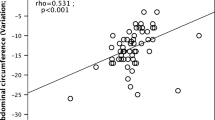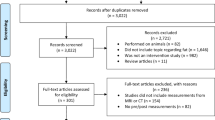Abstract
SETTING: This study was performed on free living subjects attending the body composition laboratory on a monthly basis for a total of six months.
SUBJECTS/DESIGN: Thirty-one abdominally obese men (30 <body mass index (BMI) <40, waist-to-hip ratio (WHR)>0.95) were enrolled in a placebo-controlled randomized double-blind study, using either dexfenfluramine (d-fen) or placebo, whilst also receiving food and fitness counselling. After a two week run-in period they were randomized to either d-fen or placebo for three months. This was followed by a further three months without medication, although food and fitness counselling continued.
METHODS: Body composition assessment included anthropometry (weight, height and abdominal circumferences), dual-energy X-ray absorptiometry (DEXA) for total body fat, and intra-abdominal fat measured via magnetic resonance imaging (MRI) at the L3/L4 level. Biochemistry included serum lipids, insulin and glucose. All measurements including blood pressure were performed at baseline, three months and six months.
STATISTICAL ANALYSIS: The change within each group in the three months on medication (d-fen or placebo) was assessed by paired t-tests, whilst the difference between the groups at baseline and at three months (measured by percentage change from baseline) was assessed by unpaired t-tests. An analysis of variance was performed over the six months for the d-fen group and the placebo group separately, to determine the overall effect of three months treatment with either d-fen or placebo, three months after medication had ceased.
OUTCOMES AT THREE MONTHS: At three months, BMI decreased by −5.8±0.8% in the group on d-fen and by −2.7±0.8% in the placebo group (P<0.01 d-fen vs placebo). There was also a significant difference in the reduction of the visceral fat area between the groups (−21.0±4.0% in the d- fen group vs −6.7±2.2% in the placebo group, P<0.01) although there was no significant difference between groups with regard to reduction in subcutaneous fat area. The visceral∶subcutaneous fat ratio (V/S ratio) was significantly reduced between groups at three months (−13.3±4.9% in the d-fen group vs −0.7±3.0% in the placebo group, P=0.03). At three months, the only metabolic parameters to show significant difference between the two groups were total cholesterol and LDL cholesterol. Total cholesterol reduced by −12.4±2.0% in the d-fen group compared with −2.3±2.1% in the placebo group (P<0.01). LDL cholesterol reduced by −15.6±2.6% in the d-fen group compared with −1.2±2.8% in the placebo group (P<0.01).
OUTCOMES AT SIX MONTHS: In the d-fen group, the reductions in BMI, abdominal circumference and % total body fat (DEXA) were sustained after three months on no medication, whereas all changes in body composition seen in the group on placebo at three months, had reverted at the three month follow-up. Both groups sustained a reduction in the insulin to glucose (I/G) ratio and systolic and diastolic blood pressure for three months after medication was ceased, while those on d-fen initially also maintained a reduction in total and LDL cholesterol.
This is a preview of subscription content, access via your institution
Access options
Subscribe to this journal
Receive 12 print issues and online access
$259.00 per year
only $21.58 per issue
Buy this article
- Purchase on Springer Link
- Instant access to full article PDF
Prices may be subject to local taxes which are calculated during checkout
Similar content being viewed by others
Author information
Authors and Affiliations
Rights and permissions
About this article
Cite this article
Marks, S., Chin, S. & Strauss, B. The metabolic effects of preferential reduction of visceral adipose tissue in abdominally obese men. Int J Obes 22, 893–898 (1998). https://doi.org/10.1038/sj.ijo.0800678
Received:
Revised:
Accepted:
Published:
Issue Date:
DOI: https://doi.org/10.1038/sj.ijo.0800678
Keywords
This article is cited by
-
Changes in Body Composition with Weight Loss: Obese Subjects Randomized to Surgical and Medical Programs
Obesity (2007)
-
Adipose Tissue Quantification by Imaging Methods: A Proposed Classification
Obesity Research (2003)
-
Influence of undersampling on magnetic resonance imaging measurements of intra-abdominal adipose tissue
International Journal of Obesity (2003)
-
Reduction of visceral adipose tissue during weight loss
European Journal of Clinical Nutrition (2002)



